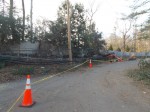New Castle Explores Storm Response Improvements

With the ordeal of Hurricane Sandy fresh in New Castle residents’ memories, the town board appealed for suggestions last week on how the municipality’s emergency operations could be improved in the future.
Enhancing communication through the town’s website and phones and encouraging more people to sign up for the town’s Nixle alerts are two avenues that must be addressed, officials said. Digitizing the map of streets to help Con Ed and out-of-town crews navigate the roads should also be considered along with reexamining the town’s tree law in an attempt to minimize damage caused when they fall.
“The town needs to do better at providing more timely and accurate information and we have to develop a system by which Con Ed is responsive to the needs of the municipalities with more timely and accurate information,” said Supervisor Susan Carpenter.
The Nov. 13 public session at town hall came less than 48 hours after power was fully restored to the town. New Castle was one of the hardest hit municipalities in Westchester, with more than 5,500 of its 6,500 customers losing power during the Oct. 29 storm. Most of those customers were without electricity for one to two weeks.
For close to two hours last week, residents brainstormed with the board on how response and lines of communication can be improved. While widespread outages were anticipated with the predicted severity of the storm, several residents said the coordination between Con Edison and the town appeared woefully inadequate.
“It’s surprising to me that Con Ed and the town board and the town government isn’t able to communicate more effectively,” said eight-year Chappaqua resident Steve Cahmi, “I don’t think it’s right that we’re in this predicament now because we had Hurricane Sandy. We’ve had plenty of other bad storms in the past and yet we still don’t know that things are coming. It doesn’t make sense to me and it’s not right.”
Some residents were confused and frustrated that crews out on the road were idle for long stretches of time. Officials explained that the town’s DPW cannot cut trees that have live wires touching them. Once Con Ed cuts the power to those wires, tree clearing on roads can proceed.
Town Administrator Penny Paderewski said while some 4,000 people are signed up for the police Nixle alert system, there are only about 400 residents who subscribe to the town Nixle, which issues a separate set of alerts. Residents can activate those alerts by registering on the town’s website.
Councilman Jason Chapin said a big obstacle was that Con Edison failed to have enough crews on the ground throughout the area once the severe weather subsided.
“We’re going to have a conversation with Con Ed to find out why that was and what they’re going to do next time to make sure that doesn’t happen again,” Chapin said.
Resident Ralph Byers urged the town to explore revising its tree laws to allow for the removal of trees that could take out power lines. Throughout the town, trees are leaning over wires and it’s a matter of time before the next storm topples them, leading to more outages, he said.
“We should be proactive,” Byers said. “We should take them down. I’m sorry we’ve got to take them down because it would be better. We can’t stop all of this but it would be better to have two large trees down on (Route) 120 between the top of the hill and town rather than 20.”
Another suggestion came from resident Susan McGrath, who urged the town to once again look into burying the power lines. Although prohibitively expensive, McGrath said perhaps the town can target certain areas that are either prone to outages or where there are important lines that knock out large blocks of customers at one time.
Several years ago, officials learned it would cost about $1 million for power lines in a portion of downtown Chappaqua to be placed underground.
Councilman Robin Stout suggested the town have an electronic street grid to help utility crews. The same could possibly be done for the town’s electric grid. Another idea was to discuss with Con Edison imposing a system-wide shutdown in advance of a severe storm, similar to what the MTA does with Metro-North. That would cut down on delays where crews would wait for power to be cut to the lines.
Police Chief Charles Ferry said while there were certainly difficulties, the town’s Emergency Operations Center at town hall worked well. He also reminded the board and the public that Con Edison did accurately project that all customers would restored by the end of Nov. 11. Full restoration occurred the next morning.
“I don’t think anybody, no matter what, on the town board or anybody in the EOC, as much as we tried, I don’t think anybody was going to move that time line up,” Ferry said. “Your government–local government–did everything in its power to handle this situation the way it should but Con Ed needs to be a lot more responsive and we need to look at the issues with them.”

Martin has more than 30 years experience covering local news in Westchester and Putnam counties, including a frequent focus on zoning and planning issues. He has been editor-in-chief of The Examiner since its inception in 2007. Read more from Martin’s editor-author bio here. Read Martin’s archived work here: https://www.theexaminernews.com/author/martin-wilbur2007/
